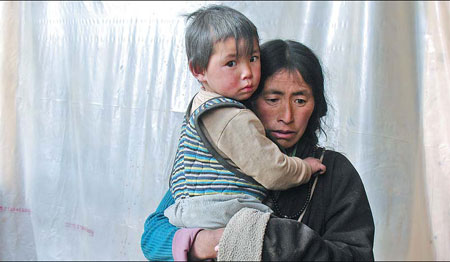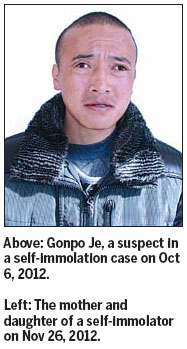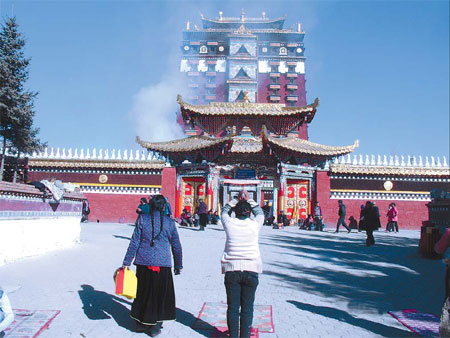Families suffer amid Tibetan flames of deceit
Updated: 2013-02-05 07:46
By Li Huizi, Jiang Weichao and Zhang Chunxiao in Gannan, Gansu (China Daily)
|
||||||||
|
Hezuo Monastery in Gannan, a Geluk monastery founded in 1673, is home to 147 monks. Photos by Li Xiaojun / for China Daily |


Myths and falsehoods help lure people to fatal act, report Li Huizi, Jiang Weichao and Zhang Chunxiao in Gannan, Gansu.
As his black cat leaned toward him, Chirarab sat on a bed with his legs crossed, wondering why his son chose to end his life in a premeditated self-immolation.
"He was so foolish. I did not educate my son well," said the 63-year-old Tibetan veterinarian.
His son, 31-year-old Tsekho, did not get along well with his wife before his death. He wanted to start a business and make money and asked his father for start-up funds. However, Chirarab refused and scolded him, as he was worried his alcoholic son would squander the money on excessive gambling and drinking.
After hearing that self-immolation could make him a "hero", Tsekho told his friends, "I would rather burn myself than live like this".
He set himself on fire beside a bridge in his village on Nov 29, 2012. Two of his friends fed the fire by pouring gasoline onto a woolen blanket and throwing the blanket to Tsekho. Another two villagers sent photos of his self-immolation overseas, along with his detailed personal information.
Some foreign media later branded Tsekho a "Tibetan martyr" protesting the growing influence of Han Chinese on the Tibetan plateau. They also used his story as an excuse to attract international attention to the so-called Tibet issue and the ultimate pursuit of "Tibetan independence," a campaign spearheaded by the Tibetan government-in-exile, with the Dalai Lama as its spiritual leader.
Villagers carried Tsekho's corpse to his parents' home and gave Chirarab the grievous news of the death of his only son.
Copycat suicides
Chirarab lives in Luchu county, Gannan Tibetan autonomous prefecture, in northwest China's Gansu province, located on the eastern edge of the Qinghai-Tibet Plateau. Gannan borders Tibetan-inhabited areas in Qinghai and Sichuan provinces.
Copycat self-immolations spread in the border area of Qinghai, Sichuan and Gansu provinces last year, mostly involving young people under the age of 30.
Sangdegye, 18, lay in a bed in the burns department of Gansu Provincial Hospital in the provincial capital of Lanzhou after having his leg amputated below the knee last year.
The young man from Gannan's Xiahe county recalled buying three liters of gasoline and a handful of painkillers at a village store on Dec 2, 2012.
He drove a borrowed motorcycle toward the nearby Bora Temple. Dressed in his Tibetan robe, he doused himself in gasoline. After the fire took hold, he ran to the temple. But he forgot to take the painkillers he had bought, and in his immense pain, he took off his fiery clothes and caught the attention of nearby police.
Police investigations show that Sangdegye was introverted and believed in the Dalai Lama clique saying that self-immolations were a sacrifice for the great Tibetan undertaking. One of his friends set himself alight and died on May 27, 2012, a move that shocked Sangdegye.
Sangdegye used to watch Voice of America Tibetan-language programs, and said he adored the self-immolators VOA reported on, because they were like "heroes".
"I was startled when I learned that my son set himself ablaze. Although such things have happened recently, I never thought that it could fall on my family," said Tsering Tokyi, Sangdegye's father.
Sangdegye's mother, Wandetso, rested her head on her knees when she spoke about her son. She quietly recited Buddhist sutras and rubbed her prayer beads, but later the sutras gave way to sobs.
"We don't know how to move on," said Namgyal, Sangdegye's grandfather.
A Tibetan official with the Gannan prefecture government said the Dalai Lama clique often chooses Tibetans facing financial pressures who have received little formal education, young people or those caught in family feuds as the targets to incite self-immolations. Instigators have sometimes told potential self-immolators that the Dalai Lama will "pray for you after your death".
Tibetan Buddhism's traditional belief in the afterlife also plays a role in self-immolations. The monk, who fled Tibet for India after a failed uprising in 1959, once said those who commit self-immolation in this life will be reborn in the afterlife.
"It is sheer destruction of humanity," said the Tibetan official who asked not to be named. "Why did you goad 17 or 18-year-olds to self-immolate? Why didn't you self-immolate?"
Loss of life
Gannan Tibetan autonomous prefecture boasts 121 Tibetan Buddhist monasteries, the most renowned being Labrang Monastery, one of the six great temples of the Geluk school of Tibetan Buddhism. The Hezuo Monastery, a Geluk monastery founded in 1673, has 147 monks.
On the morning of Jan 12 (Dec 1 in the Chinese lunar calendar) a phalanx of more than 40 monks from Hezuo Monastery were rehearsing a religious dance for a grand Buddhist ceremony scheduled for the 14th day of the lunar January (Feb 23.) Their chanting broke the morning silence.
It was a Saturday. Children in the neighborhood came in twos and threes to play in the monastery. At the sight of the sutra hall, they went in and knelt down to worship.
Believers - Tibetans and Han people alike - circled the white tower erected near the monastery, chanting prayers. Their bicycles and scooters were parked nearby.
There were no traces of the fire that cost a Tibetan woman her life about six months earlier.
On Aug 7, 2012, Trakhutso, 26, enveloped in flames, rolled on the hillside northwest of the white tower, murmuring, "Let me die. Let me die."
The fire was put out by another Tibetan woman, who had been circling the tower.
Soon after, a monk from Hezuo Monastery named Chophel arrived at the site. He took pictures of Trakhutso and with the help of some other monks, carried her to the office of the monastery's management committee.
He neither called the police nor sent the injured, but still living, woman to the hospital, thus delaying Trakhutso's treatment.
According to Chophel's police confession, he used his mobile phone to transmit four pictures of the self-immolator, her name and those of her parents and "her statements about the return of the Dalai Lama and the freedom of Tibetans" to people abroad.
The four pictures were exactly what some foreign media used in their reports of the incident.
Chophel has since been arrested on suspicion of intentional homicide.
Police found that Trakhutso, who had a problem with her left leg, had sour relations with her husband and his family. More often than not, she was subjected to blame and bullying from her mother-in-law.
During Spring Festival in 2012, Trakhutso's sister-in-law praised self-immolators in a conversation, saying, "How awesome! What they did was for the return of the Dalai Lama and the undertaking of the Tibetans!"
Four days before Trakhutso ignited herself, she had a physical examination, in which she was diagnosed with a common gynecological disease. It was then that the idea of giving up her life took hold.
Trakhutso went back to her parents' home on Aug 6. She heard her father say, "Self-immolators, even if they die, are so lucky to have the Dalai Lama to atone for their sins with scripture chanting."
Trakhutso got carried away by these statements.
"The belief that people who burn themselves to death will have their souls released from purgatory and attain bliss in the afterlife is never part of the Buddhist creed," explained 62-year-old Sodzamtsang Rinpoche from Hezuo Monastery.
"Self-immolation is not a heroic act, but a stupid one that misinterprets Buddhist doctrine."
But Sangye Gyatso, a 26-year-old resident of Duohe village, Nawu township in the city of Hezuo, the seat of the prefectural government of Gannan, saw it differently.
After Trakhutso died, Sangye Gyatso told his friends over drinks, "[The city of] Hezuo has risen to fame because of a woman. For Duohuo [village], it will be because of me."
According to his confession to police, he and several friends used their cell phones to spread pictures of a burning Trakhutso. He was also a regular viewer of the VOA's Tibetan-language programming.
Police have confirmed that Sangye Gyatso installed a satellite receiver in his house and used to watch VOA Tibetan-language programs every Monday, Wednesday and Friday. Broadcasts about "Tibetan independence" and self-immolations had a great impact on him and his friends.
On Oct 6, 2012, Sangye Gyatso died in the fire he lit himself.
Police investigations show that Sangye Gyatso was handled in accordance with the law in 2007 for repeated acts of theft, which were carried out with the help of others. He had been without a job for a long time.
Khyi Gyatso, 33, a village friend of Sangye Gyatso's, had been a monk at the local Duohe Monastery before leaving China through illegal means to become a monk in an Indian monastery in 2000.
As a key member of the "Tibetan Youth Congress," Khyi Gyatso introduced Sangye Gyatso to ideas about "Tibetan independence" during his stay in China in 2011.
After returning to India in September 2011, Khyi Gyatso continued to contact Sangye Gyatso by phone and e-mail, urging him "contribute to the cause of Tibetans and improve his status and that of his family" by following the pattern of the "heroic deed" of self-immolation.
In January 2012, Khyi Gyatso and Gonpo Konchoghu, another member of the "Tibetan Youth Congress" as well as a former monk at Duohe Monastery, held a meeting in India with around 30 monks from Gansu's Gannan Tibetan autonomous prefecture, who were in India at the time for a so-called "religious session" held by the Dalai Lama clique. The monks included 41-year-old Kalzang Gyatso and 32-year-old Gonpo Je.
The meeting was about planning the self-immolations of Tibetans in China.
In April 2012, Gonpo Konchoghu illegally entered China and urged Sangye Gyatso to self-immolate, promising to send his picture overseas afterwards and to request that the Dalai Lama arrange a religious session for him in India.
On Oct 6, 2012, Sangye Gyatso phoned three people, including Gonpo Je, about the time and place of his self-immolation.
After Sangye Gyatso set himself on fire, Tashi Gyatso and Gonpo Je, among others who were all there waiting, took photos of the self-immolation process and quickly sent them overseas.
That afternoon, Khyi Gyatso, who was then overseas, released the "news" about the self-immolation. Shortly afterward, the Dalai Lama clique launched a high-profile "propaganda" campaign on the well-orchestrated incident, claiming there was a "humanitarian crisis" in China and calling for the international community to interfere.
Gansu police have apprehended seven principal suspects, including Kalzang Gyatso, Gonpo Je and Tashi Gyatso.
Chinese police have also requested that police in relevant countries help investigate Gonpo Konchoghu via channels for international police cooperation.
But these efforts have failed to stop the flames of self-immolations from spreading further and claiming more lives.
On Oct 23, 2012, Togye Rinchen, a 58-year-old Tibetan villager, set himself on fire near a shopping center in Gannan's Xiahe county. Those who incited the self-immolation also provided pictures to the VOA.
On Jan 31, six ethnic Tibetans were sentenced to three to 12 years in prison for their roles in Togye Rinchen's self-immolation by the Xiahe County People's Court.
Located more than 70 km from the city of Hezuo, the prefectural capital, Xiahe is considered the prefecture's religious center.
After spotting the incident, police officers put out the fire, with Togye Rinchen still showing signs of life.
As police officers worked to rescue the self-immolator, some monks and people in the crowd attempted to carry him into the monastery. They attacked and injured the officers, hampering their rescue efforts.
"When I saw the self-immolator's left hand still moving, I grabbed an extinguisher and soaked quilt and tried to save him," Liu Yaguo, a police officer from the county's public security bureau, recalls. "But a crowd was already gathering. A woman tried to stop me by lashing me with a belt and a tall man beckoned more people over."
Terrorism
Urigtsang, a young Living Buddha from Hezuo Monastery, says self-immolations go against Buddhist doctrine and Chinese law.
Monks should focus their attention on practising Buddhism and cherishing life, and then they will have a good afterlife, he explained, adding that according to Buddhist scriptures, if someone ends his or her life by self-immolating, their soul cannot be reincarnated.
"Self-immolations are individual behavior and have nothing to do with monasteries and the general public," Urigtsang said.
After being instigated by others, some monks have deliberately hindered efforts to save self-immolators, which is also their personal choice, he added.
According to the 1994 UN declaration on Measures to Eliminate International Terrorism, criminal acts intended or calculated to provoke a state of terror in the public, a group of persons or particular communities for political purposes are not justifiable under any circumstances, no matter the considerations of a political, philosophical, ideological, racial, ethnic, religious or any other nature that may be invoked to justify them.
From his hospital bed, Sangdegye said he was too young to tell right from wrong and tended to act on impulse.
"I really regret it," he said, adding that he wants to get artificial limbs in the future so he will be able to walk.
After his failed self-immolation on Dec 2, he was sent to a hospital and was diagnosed as "critically ill", as there were burns across a large part of his body as well as in his respiratory system. After four major surgeries, his organ functions gradually returned to normal.
"At first, I thought I was a hero, but now, I am an idiot," he wrote in his notebook, next to a picture of a sunflower.
Doctors and nurses accompany him around the clock, and when the nurses change his dressings, he always thanks them, said Deng Jinju, China's top burns care expert who supervises Sangdegye's medical treatment. Gansu Provincial Hospital covered his medical fees.
"I feel sad when I see him, as he is at the tender age of 18," Deng said.
Namgyal, Sangdegye's grandfather, hopes that other families will not have to deal with such a tragedy.
(China Daily 02/05/2013 page6)

 In Photos: 7.0-magnitude quake hits Sichuan
In Photos: 7.0-magnitude quake hits Sichuan
 Li Na on Time cover, makes influential 100 list
Li Na on Time cover, makes influential 100 list
 FBI releases photos of 2 Boston bombings suspects
FBI releases photos of 2 Boston bombings suspects
 World's wackiest hairstyles
World's wackiest hairstyles
 Sandstorms strike Northwest China
Sandstorms strike Northwest China
 Never-seen photos of Madonna on display
Never-seen photos of Madonna on display
 H7N9 outbreak linked to waterfowl migration
H7N9 outbreak linked to waterfowl migration
 Dozens feared dead in Texas plant blast
Dozens feared dead in Texas plant blast
Most Viewed
Editor's Picks

|

|

|

|

|

|
Today's Top News
Live report: 7.0-magnitude quake hits Sichuan, heavy casualties feared
Boston suspect cornered on boat
Cross-talk artist helps to spread the word
'Green' awareness levels drop in Beijing
Palace Museum spruces up
First couple on Time's list of most influential
H7N9 flu transmission studied
Trading channels 'need to broaden'
US Weekly

|

|








